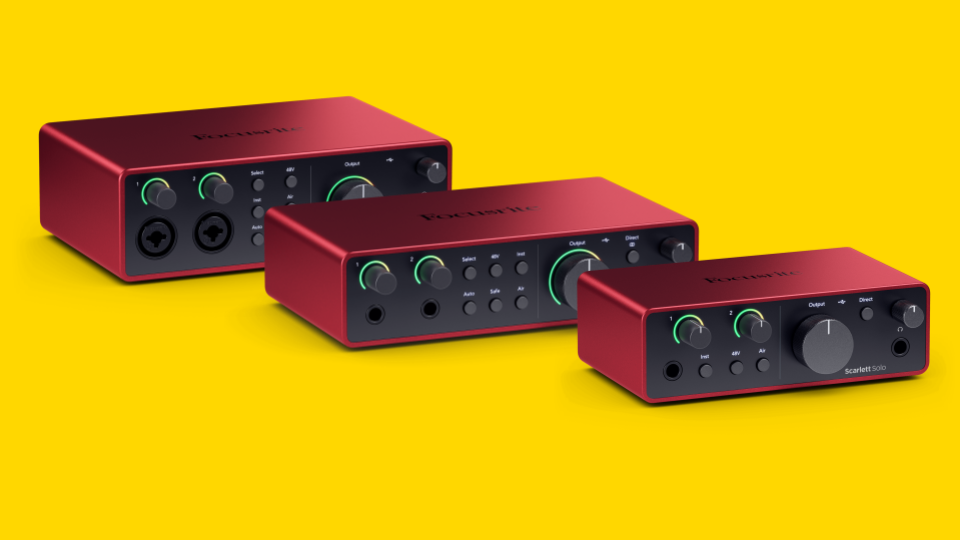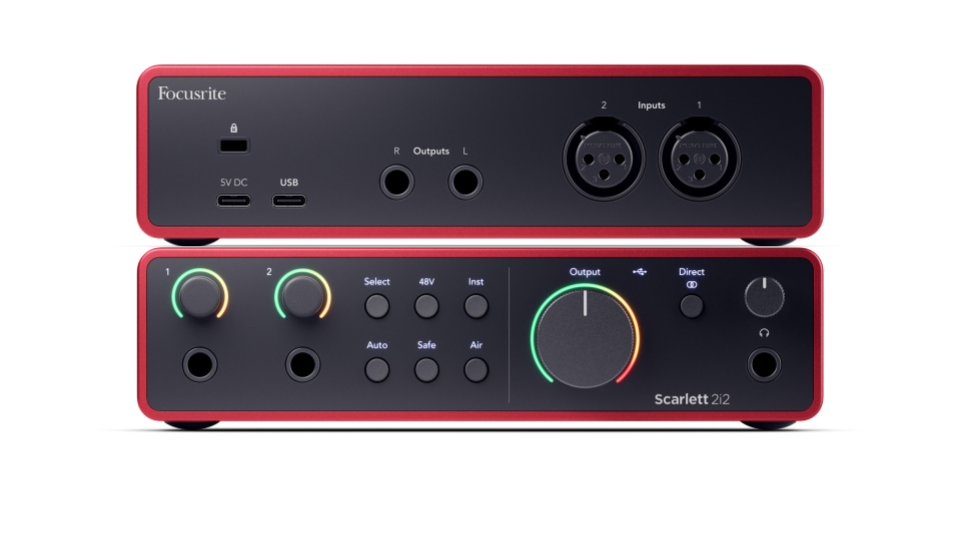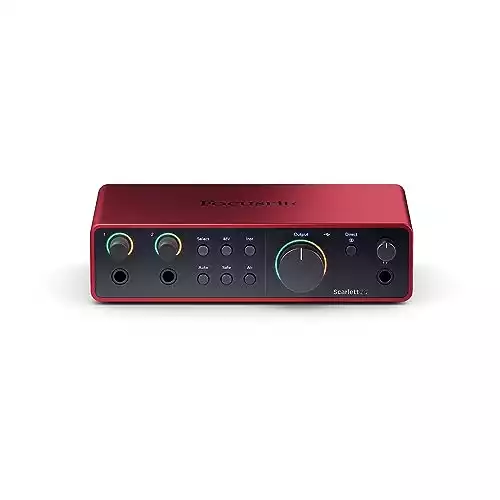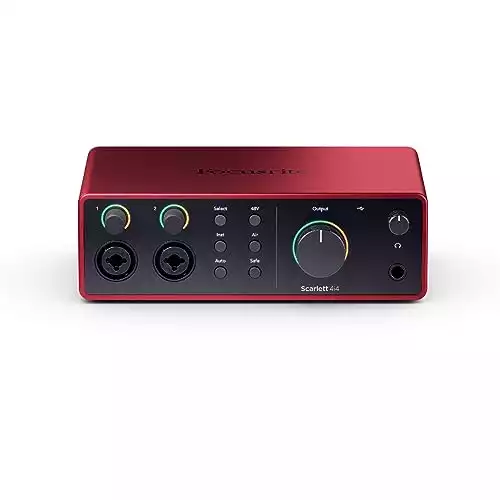If you’ve had any involvement with audio production, there’s no doubt you’ve at least heard of Focusrite Scarlett audio interfaces. And there’s a good chance you’ve used one before, too.
But with the release of the new 4th generation, you might be wondering if it’s time for an upgrade.
Whether you’re looking to upgrade, or your shopping for your first audio interface, this guide will help you understand the new Focusrite Scarlett 4th Gen interfaces.
Affiliate Disclaimer
Sonic Atlas is reader-supported. We may earn a commission if you purchase a product using one of our links, at no additional cost to you.
Quick Look: Every 4th Gen Scarlett Audio Interface Available in 2023
|
$199.99
|
$139.99
|
$279.99
|
|
|
|
- 2 XLR and line inputs
- 2 line outputs
- Improved preamps and converters
- 2 Air Mode settings (high & mid boost)
- Auto-Gain & Clip-Safe modes
- Large software bundle included
- 1 XLR input and 1 line input
- 2 line outputs
- Improved preamps and converters
- 2 Air Mode settings (high & mid boost)
- Large software bundle included
- 2 XLR/line combo inputs, plus 2 additional line inputs
- 4 line outputs
- MIDI in/out
- Improved preamps and converters
- 2 Air Mode settings (high & mid boost)
- Auto-Gain & Clip-Safe modes
- Large software bundle included
As of this writing, these are the only 4th generation interfaces available. There aren’t any upgraded versions of the 8i6, 18i8, and 18i20 yet.
What’s New in the 4th Generation?
Focusrite released the 4th generation of Scarlett interfaces starting in Late August/September 2023. This new refresh offers a few significant upgrades and changes over the previous 3rd gen.
Split XLR & Line Inputs
Previous 2i2 and 4i4 models used combo XLR/Line inputs. The new 4th gen interfaces now split them up, with XLR ports on the backside and 1/4-inch line inputs on the front.
Many people keep their interfaces in a permanent place on their desk. So having the XLR cables run behind the device certainly helps with cable management.
Even though they’re split up, it doesn’t actually double the number of available inputs. XLR 1 and Line 1 still occupy the same channel. Same goes for the 2nd channel.
That said, the 4i4 4th Gen still uses two front-facing combo inputs with four line inputs on the rear.
Improved Preamps & Gain Range
4th gen interfaces feature an extra nice 69db gain range for XLR input. This makes them more friendly with gain-hungry mics like the Shure SM7B.
On top of that, it also features a 62db gain range for line inputs.
Compare that to the 3rd generation’s 56db gain range for both XLR and line inputs. While respectable, it wasn’t enough to satisfy some naturally quiet devices.

Improved Monitor & Headphone Outputs
The 4th generation main line outputs now offer up to 120db dynamic range, compared to the 3rd generation’s 108db.
Likewise, the headphone amps also saw improvements. 4th gen can now output up to 115db versus the 3rd gen’s 108db.
All that to say the 4th generation Scarletts can output audio at higher volumes.
Hi-Z & Line Inputs
Each line input now features upgraded “hi-z” inputs, similar to what you’d find on a guitar amp. This lets you record more accurate-sounding guitar signals directly into the interface.
Aside from that, the dedicated line inputs offer greater fidelity for other DI instruments like keyboards and synthesizers.
Improved Converters
4th gen interfaces now feature the same 192 kHz, 24-bit converters found in Focusrite’s RedNet studio interfaces. In other words, it features better-quality circuitry for recording high-fidelity audio with less electronic noise.
Auto-Gain
Auto-Gain was a feature found on Focusrite’s Vocaster line of audio interfaces. As the name suggests, this feature will read your signal and automatically set it to the perfect gain level. Just speak, sing, or play for 10 seconds, then the interface will adjust the gain for you.
Clip Safe Mode
With this mode activated, the interface will automatically reduce your gain levels to prevent clipping and distortion, saving you from doing multiple takes.
This mode is only available on the 2i2 and 4i4. You won’t find it on the Scarlett Solo, though.
Two Air Modes
The 4th generation interfaces now feature two Air modes:
- Presence — Introduced in the 3rd generation. The presence mode boosts the high end of a signal. It puts your recordings to the front end of a mix, which helps things like vocals and lead instruments cut through a mix.
- Harmonic Drive — This new mode boosts a signal’s mid-range for more punch and body. It’s especially useful for instrumentalists, but vocalists can put it to good use too.
Optional External Power
In addition to the main USB-C connection, there’s an extra USB port dedicated to external power. This lets you use your Scarlett with mobile devices that would otherwise not provide enough power.

What’s Stayed the Same?
Even with all the improvements and changes, some things remain the same between the 3rd and 4th generation interfaces.
Red Metal Chasis
The Scarlett’s iconic red metal body is still on full display with the 4th generation. The new interfaces use recycled aluminum for better environmental sustainability.
48V Phantom Power
Phantom power is still available on the new Scarletts. You can turn it on and off for both XLR inputs, but can’t control them independently.
Direct Monitoring
The direct monitoring system has remained the same. It allows you to hear the latency-free signal that’s directly being fed into the interface, as opposed to the processed output signal.
Further Reading: What is Direct Monitoring?
Number of Inputs & Outputs
Each model has the same number of inputs and outputs as their predecessors.
Scarlett Solo
- Inputs: 1 XLR input, 1 line input (2 total)
- Outputs: 2 line output (Left & Right)
Scarlett 2i2
- Inputs: 2 XLR, 2 line (2 total, mic & line can’t be run independently)
- Outputs: 2 line output (Left & Right)
Scarlet 4i4
- Inputs: 2 XLR/line combo inputs, 2 line inputs (4 total)
- Outputs: 4 line outputs
- MIDI In/Out: 5-pin MIDI cable ports
Bundled Software
4th Generation Scarletts come with a suite of software, including Focusrite’s Hitmaker Expansion bundle.
While I’d never recommend getting an interface just for the software, it’s a nice bonus — especially if you’re relatively new to music production.
Here’s what you get:
DAWs
- Ableton Live Lite
- Pro Tools Artist (3-month subscription)
Virtual Instruments
- Native Instruments Massive
- XLN Audio Addictive Keys
- XLN Audio Addictive Drums 2
Subscription Services
- Landr 2-month subscription, plus 5 free masters
- Splice 3-month subscription
Mixing, Mastering, and Effects Plugins
- Antares Auto-Tune Access
- Brainworx Bx_console Focusrite SC
- FAST Balancer
- Red 2 & 3 Plug-in Suite
- Relab LX480
- Softube Marshall Silver Jubilee 2555
- Sonnox Vox Doubler
Which 4th Gen Scarlett Interface Is Right For You?
All the Scarlett interfaces can do roughly the same things. So which one you pick largely depends on how much recording you do:
- Scarlett Solo — The Solo interface is great if you only do light recording and streaming by yourself.
- Scarlett 2i2 — Get the 2i2 if you frequently record in stereo, podcast with a co-host, or like to record two sources at the same time.
- Scarlett 4i4 — The 4i4 is great if you do more complex recording setups with keyboards and other DI instruments.
Are These Scarlett Interfaces Good for Beginners?
The Scarlett Series are the world’s best-selling audio interfaces for a good reason. They’re easy to use, they sound fantastic, and they’re highly affordable.
If you’re a beginner, any one of these Scarlett interfaces is going to be a fantastic option that lasts you for years to come. And it’s not unrealistic to say that they could be the last audio interface you’ll ever need.
The bundled software is a nice bonus for beginners too. It’ll give you a solid set of instruments, loops, and effects to help start your plugin collection.
Should You Upgrade from a 3rd Generation Scarlett Interface?
The 4th Gen Scarlett interfaces have several benefits over their predecessors. But a few features in particular make them a compelling upgrade:
- The improved preamps and gain range make some dynamic mics more viable without extra gear, like the Shure SM7B.
- Auto-Gain and Clip Safe Mode help automate input levels, taking out some of the guesswork for beginners.
- Having two different Air modes gives you more EQ options to experiment and record with.
If any of those features are important to you, then the 4th Gen Scarlett audio interfaces would be a fantastic upgrade.
But if you mostly record with neutral EQ settings, or you already have other gear to support gain-hungry microphones, then there isn’t as much reason to upgrade.
A super-reliable audio interface that's perfect for any home studio. The 2i2 offers two inputs with built-in preamps for recording higher-quality audio. Plus, the new Auto-Gain features takes out the guesswork in setting input levels. It's the perfect, easy-to-use interface for any musician and podcaster.
- Improved gain makes some dynamic mics more usable
- 2 Air Mode settings — hi-range boost and mid-range boost
- Auto-gain and Clip Safe modes take out guesswork in setting input levels
- Rugged build quality
- Includes software bundle
- Split XLR and line inputs may confuse new users
An incredibly robust and versatile audio interface for solo musicians and creators. The Scarlett Solo comes with 1 XLR input and 1 line/instrument input. It's small, has a rugged build, and can record audio with pristine quality.
- Rugged build quality
- Improved RedNet circuitry for hi-fidelity audio
- 2 Air Mode settings — hi-range boost and mid-range boost
- Includes software bundle
- Preamp gain could be higher
- Lacks features from other 4th gen Scarlett devices
Want More Detailed Comparisons? Check Out These Focusrite Scarlett Head-to-Heads
We’ve put together some direct comparisons between each of these Focusrite interfaces and their predecessors.
- Focusrite Scarlett 2i2 4th Gen vs 3rd Gen
- Focusrite Scarlett Solo 4th Gen vs 3rd Gen
- Focusrite Scarlett 4i4 4th Gen vs 3rd Gen
You can also compare the two most popular models against each other.
Discover More Beginner-Friendly Audio Interfaces
Whether it’s 3rd gen or 4th gen, the Focusrite Scarlett 2i2 is easily our top choice for beginner audio interfaces. But, there are plenty of other options available. Check out our roundup of the best beginner audio interfaces.





